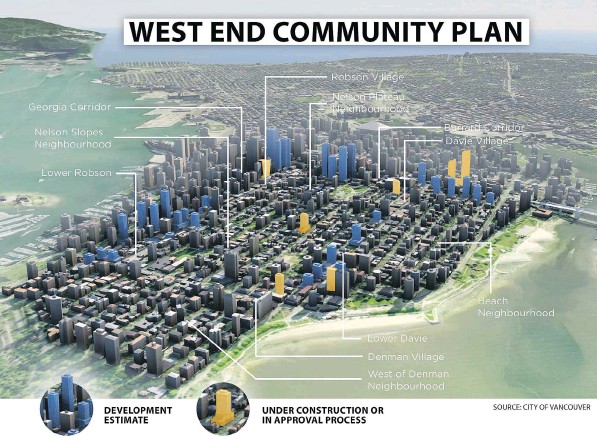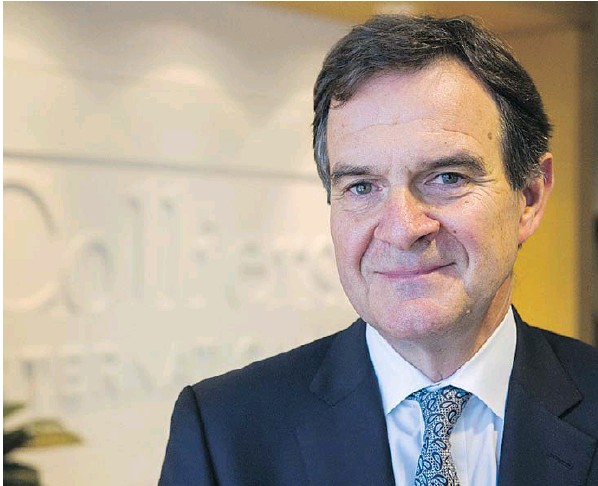John Mackie
The Vancouver Sun
Recently a developer approached the strata council of 1188 Cardero in the West End of Vancouver about buying the property.
As part of the city’s West End plan, the site has been rezoned for a building up to 190 feet tall. And the real estate sharks are circling.
“I’m going to say we’ve talked to five brokers and maybe four developers in the last two months,” said Jeff Otto, a member of the building’s strata council.
“I think the writing was on the wall, when you look at the neighbourhood. You’ve got two towers going up in the Safeway (site) across from us on Davie, (and) there’s a tower going up in the London Drugs (site) across from the Safeway.
“Down the street there’s a tower going up where the Mac’s is at Bidwell and Davie, and up the street at Jervis (and Davie) there’s a tower going up there as well.”
The towers are springing up as part of the 2013 West End plan, which seeks to add 10,000 people to the neighbourhood.
Many of the newcomers are to be housed in towers on or around Davie, West Georgia and Burrard. Depending on the site, you can build between 190 and 550 feet into the sky.
The plan calls for 20 to 25 per cent social or rental housing on many of the new projects. Some are pure rental buildings, but many of the towers seem to be developing as high-end condos, selling for upwards of $1,000 a square foot.
The catch is, developers usually have to buy existing buildings in order to get a site.
“Generally speaking, there’s no land left in the city,” said Kirk Kuester of Colliers International. “There’s no land left to develop in the areas in which developers are focused, which are the more urban markets where there’s lots of demand for end-product to either buy or rent. (So) you have to re-purpose a site.”
In the past it was hard for developers to buy entire strata buildings, because it was difficult to get 100 per cent of the owners to sign off on a deal.
But the provincial government is bringing in new rules that allow a strata building to be sold if 80 per cent of owners agree to a sale. It has yet to be enacted into law, but developers have been rushing in to try to lock up sites.
Some buildings have already been sold, like two rental apartment blocks at 1070 and 1080 Barclay, which sold for $59 million in January. Two other rental apartment blocks, 1059 and 1075 Nelson, went for $60 million in March.
Prices have been rising quickly. Wall Financial paid $16.8 million for 1059 and 1075 Nelson in Sept., 2013, but 30 months later sold it for $60 million to Suncom, a controversial company that has been pooling resources from wealthy Chinese immigrants.
Ian Young of the South China Morning Post found Suncom had flipped the properties to another wealthy immigrant, Gao Shan, for $68 million. Which means two nondescript three-storey walk-ups increased in value 400 per cent in two-and-a-half years.
The size of the current building isn’t what matters, it’s what can be built on the site. The Nelson properties are in an area where you can build up to 550 feet, so the price soared.
“It’s based on a price per buildable foot,” said real estate broker Eugen Klein.
“That price per buildable foot then converts into what each individual owner (in a strata or co-op) will get. Typically you’re seeing some pretty high prices, especially for the more prominent towers and places that will have water or park views that developers want.”
Klein is among the brokers that have made a pitch to represent the owners of 1188 Cardero. (A broker would represent the owners in the negotiations with developers.)
“We typically do all of the pro-formas on behalf of the clients, so that they’re as informed as the developer, and then translate that into what they can take home and see as a valuation,” said Klein.
Figuring out what can be built can be tricky, because of the city’s complex zoning rules. There are 27 “view corridors” where the city limits the height of towers to protect views of the North Shore mountains and Downtown, and many of them pass through Downtown and the West End.
Another factor is the shadow a tower would cast on neighbouring buildings.
“We represent the owners at 1075 Barclay,” said Klein. “That’s a highrise site, (which has) up to about a 550-foot height potential on their tower. But when you add the shadow corridors and all the other (city) requirements, setbacks and building plates, it’s probably closer to the 420 mark.
“So 420 feet will be what’s actually allowable. There’s this whole process of making sure you align the owners into what’s realistic, not what’s written on the zoning code, or what’s potential.”
For strata or co-op owners, the advantage of selling is that you can sometimes get $1 million or more for a unit that might be appraised for half that on the market. This can be appealing, especially for buildings that are in need of repairs.
The problem is you might have a hard time getting another place in the West End. West End realtor Rob Joyce said offshore investors have been snapping up condos that allow rentals, and many locals are having a hard time getting back into the market if they sell.
“I had a client who had up to $700,000 for a one bedroom, and it took me over four months to find her something,” said Joyce. “A one bedroom in the West End, and she had up to $700,000 to spend. And I eventually sold her a co-op, because co-ops have rental restrictions.”
Kuester said land values in certain areas have been soaring.
“In simple terms, valuations for condominium land have gone from $200 to $250 maybe 12-to-18 months ago to upwards of $450-$550 a foot, a buildable foot,” he said.
“I’m generalizing …(that’s) along Broadway, the west side, Vancouver downtown. Some are going to be higher, some are going to be lower. But that’s a metric where you can say that’s a pretty good generalization of the market.”
This is for pure land value — the cost of building would go on top.
“Essentially the land or density associated with any new unit today, a 700 foot unit in a new building, would have land (costs) associated with it of $500 a buildable foot,” said Kuester.
“(So) if it’s 700 sq. ft, the land could be worth $350,000. If it’s a thousand foot unit — and nobody’s building that — that would be worth $500,000.”
As a result, the new towers going up will probably be high end. Just how high end is anyone’s guess, because values have been soaring.
“There’s a big debate in the market as to where end values for good quality condo products stops,” said Kuester.
“You can look at buildings like One Burrard, (the) nicest building I would say announced in Vancouver in recent time. Gillespie’s Vancouver House would have been the one previous.
“So Gillespie sets the price at whatever he did, $1,000 a foot on average. Everyone went ‘Wow! Unbelievable!’ Then Reliance and Pattison come out with Burrard One, and it was whatever, $1,050 or $1,100.
“Today there’s a site that is just going to come to market. It’s what I would call a commodity site on the Downtown peninsula, nowhere near the quality of Burrard One or Vancouver House, and it’s going to come out at $1,200 a foot.
“There’s people saying the West End is going to go to $1,300, $1,400, $1,500 a foot. Certain west side markets are going to go to $1,200 or $1,300 a foot. Because that’s what it’s going to cost, that’s where the (condo) values need to be to support the acquisition of the sites that are needed.”
The competition for sites is intense, and any building in the area that has been rezoned is probably in play, no matter the age or shape. The four-storey strata building at 1188 Cardero, for example, was built in 1988, while the seven storey strata at 1075 Barclay was built in 1992.
“It’s created all sorts of complications and disruptions for owners and occupiers of apartment buildings, co-ops, and condominium buildings,” said Kuester. “Because the values of these sites as development sites are now greater than the value of the individual units.”
© 2016 Postmedia Network Inc.




